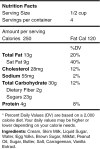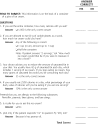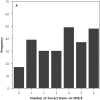Quick assessment of literacy in primary care: the newest vital sign
- PMID: 16338915
- PMCID: PMC1466931
- DOI: 10.1370/afm.405
Quick assessment of literacy in primary care: the newest vital sign
Erratum in
- Ann Fam Med. 2006 Jan-Feb;4(1):83
Abstract
Purpose: Current health literacy screening instruments for health care settings are either too long for routine use or available only in English. Our objective was to develop a quick and accurate screening test for limited literacy available in English and Spanish.
Methods: We administered candidate items for the new instrument and also the Test of Functional Health Literacy in Adults (TOFHLA) to English-speaking and Spanish-speaking primary care patients. We measured internal consistency with Cronbach's alpha and assessed criterion validity by measuring correlations with TOFHLA scores. Using TOFLHA scores <75 to define limited literacy, we plotted receiver-operating characteristics (ROC) curves and calculated likelihood ratios for cutoff scores on the new instrument.
Results: The final instrument, the Newest Vital Sign (NVS), is a nutrition label that is accompanied by 6 questions and requires 3 minutes for administration. It is reliable (Cronbach alpha >0.76 in English and 0.69 in Spanish) and correlates with the TOFHLA. Area under the ROC curve is 0.88 for English and 0.72 for Spanish versions. Patients with more than 4 correct responses are unlikely to have low literacy, whereas fewer than 4 correct answers indicate the possibility of limited literacy.
Conclusion: NVS is suitable for use as a quick screening test for limited literacy in primary health care settings.
Figures






Similar articles
-
How long does it take to assess literacy skills in clinical practice?J Am Board Fam Med. 2008 May-Jun;21(3):211-4. doi: 10.3122/jabfm.2008.03.070217. J Am Board Fam Med. 2008. PMID: 18467532
-
Brief health literacy screening items predict newest vital sign scores.J Am Board Fam Med. 2013 Sep-Oct;26(5):558-65. doi: 10.3122/jabfm.2013.05.130096. J Am Board Fam Med. 2013. PMID: 24004707
-
Development and validation of the Rapid Estimate of Adolescent Literacy in Medicine (REALM-Teen): a tool to screen adolescents for below-grade reading in health care settings.Pediatrics. 2006 Dec;118(6):e1707-14. doi: 10.1542/peds.2006-1139. Pediatrics. 2006. PMID: 17142495
-
Practical assessment of adult literacy in health care.Health Educ Behav. 1998 Oct;25(5):613-24. doi: 10.1177/109019819802500508. Health Educ Behav. 1998. PMID: 9768381 Review.
-
Can this patient read and understand written health information?JAMA. 2010 Jul 7;304(1):76-84. doi: 10.1001/jama.2010.896. JAMA. 2010. PMID: 20606152 Review.
Cited by
-
Characteristics of people with low health literacy on coronary heart disease GP registers in South London: a cross-sectional study.BMJ Open. 2013 Jan 3;3(1):e001503. doi: 10.1136/bmjopen-2012-001503. BMJ Open. 2013. PMID: 23293243 Free PMC article.
-
Greater preferences for death in hospital and mechanical ventilation at the end of life among non-whites recently diagnosed with cancer.Support Care Cancer. 2021 Nov;29(11):6555-6564. doi: 10.1007/s00520-021-06226-5. Epub 2021 Apr 29. Support Care Cancer. 2021. PMID: 33913005 Free PMC article.
-
Conceptualization, Development and Psychometric Evaluations of a New Medication-Related Health Literacy Instrument: The Chinese Medication Literacy Measurement.Int J Environ Res Public Health. 2020 Sep 23;17(19):6951. doi: 10.3390/ijerph17196951. Int J Environ Res Public Health. 2020. PMID: 32977520 Free PMC article.
-
A feasibility pilot trial of a peer-support educational behavioral intervention to improve diabetes medication adherence in African Americans.Pilot Feasibility Stud. 2022 Nov 14;8(1):240. doi: 10.1186/s40814-022-01198-7. Pilot Feasibility Stud. 2022. PMID: 36376960 Free PMC article.
-
Responses and relationship dynamics of men and their spouses during active surveillance for prostate cancer: health literacy as an inquiry framework.BMC Public Health. 2015 Aug 1;15:741. doi: 10.1186/s12889-015-2068-8. BMC Public Health. 2015. PMID: 26231177 Free PMC article.
References
-
- Nielson-Bohlman L, Panzer A, Kindig D, eds. Health Literacy: A Prescription to End Confusion. Washington, DC: National Academies Press; 2004. - PubMed
-
- Berkman N, DeWalt D, Pignone M, et al. Literacy and Health Outcomes. Summary, Evidence Report/Technology Assessment No. 87 (Prepared by RTI International - University of North Carolina Evidence-Based Practice Center under Contract No. 290-02-0016). Rockville, Md: Agency for Healthcare Research and Quality; 2004. AHRQ Publication No. 04-E007-1.
-
- Schwartzberg J, VanGeest J, Wang C, eds. Understanding Health Literacy: Inspirations for Medicine and Public Health. Chicago, Ill: American Medical Association Press; 2004.
-
- US Department of Health and Human Services. Health Communication. In: Healthy People 2010. 2nd ed. Washington, DC: US Government Printing Office; 2000.
-
- Gottfredson L. Why g matters: the complexity of everyday life. Intelligence. 1997;24:79–132.
Publication types
MeSH terms
LinkOut - more resources
Full Text Sources
